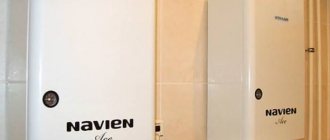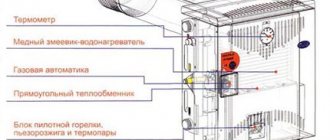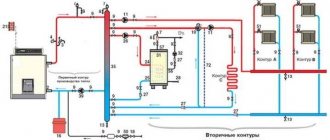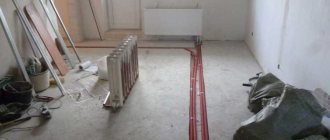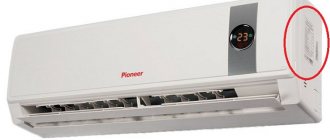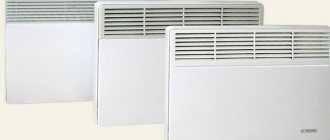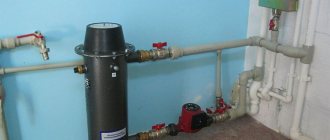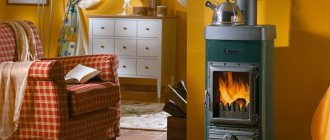Double-circuit gas boiler for heating a private house
Unlike high-rise buildings, where central heating dominates, all private houses are heated independently. Therefore, the choice of heating device is relevant for them.
Residents of the private sector can carry out heating themselves and choose the device with which their home will be heated. Due to the saturation of the market with various products, you can choose any option that suits you.
In this article we will talk about the advantages and disadvantages of a double-circuit boiler. If your house has gas, then you can install this option because it runs on gas.
First, let's figure out what it is. This boiler has two circuits and each has its own functional purpose. The first heats the water, which passes through the heating radiators and heats the entire house, and the second is designed to supply hot water to your home instead of a water heater or titanium.
A double-circuit boiler may have two heat exchangers, which, as a rule, are installed in a wall-mounted version. For devices with one heat exchanger, an additional pipe is installed through which cold water is supplied.
Floor-standing double-circuit boilers of domestic production have a primitive design. If you need to use only one circuit, then the second one will also be heated. That is, in the summer you will need hot water, and when it is heated, you will heat the room. Agree that this is a waste of fuel and useless operation of the device.
And if in winter you use the boiler only for heating, you will always have hot water. This is, of course, better than hot radiators in the summer, but still useless if you don't need hot water.
Foreign-made wall-mounted boilers have independent circuits that solve the problem of floor-mounted double-circuit devices. But if one circuit fails, then the second will not work either. Currently, wall-mounted double-circuit boilers are predominantly used, as they are more efficient than floor-mounted ones.
The big advantage of double-circuit boilers is their small size. If you have limited space in your home or would like some free space, then feel free to install such a heating device. After all, thanks to the combination of two functions in one unit, there is no need to install two devices: for heating and for heating water.
Double-circuit boilers are powerful enough to heat water both for heating and for direct use. Their power starts from 23 kilowatts. But if you need to heat water for domestic needs, the heating circuit is automatically turned off.
That is, you will be left without hot radiators for some time. Or you will heat water for use only in extreme cases. You can, of course, set up the system so that you always have two circuits hot; to do this, you just need to prevent one of them from completely cooling down while the other is running.
Basic recommendations for the operation and repair of gas boilers
- Do not open the gas valve under any circumstances. All work related to gas must be performed by a specialist. You shouldn't put your life in danger.
- As a last resort, if you have basic knowledge about the operation of gas boilers , you can check the filter at the gas pipeline inlet. Before doing this, be sure to turn off the tap, unscrew it and check the gasket.
- 80% of problems during operation of a gas boiler occur due to phase zeroing when the wire plug is incorrectly connected to the socket. For example, one of the family members unplugged the boiler and unknowingly put the plug back in the wrong position. First of all, you should pay attention to this and try to put the fork in the correct position. If this is the problem, the system will reset the error and the boiler will start working. This completes the repair of the gas boiler. In order not to get confused about the correct phase setting, you can make marks on the plug and socket with a marker, mark the pin and the corresponding hole.
- It is necessary to check the gas pressure; this can be done visually, for example, by the boiling time of the kettle. If the kettle boils longer than usual, half an hour instead of ten minutes, then the pressure is low.
- Coolant circulation. Filters are installed at the inlet to protect the boiler from debris and scale that enters it from old or low-quality systems during operation of the gas boiler. A layer of dirt forms inside the pipes, and circulation in the boiler is disrupted. In this case, you need to make sure that the system is not clogged with debris - unscrew the filter and check it. In case of contamination, rinse the filter thoroughly and replace it.
- Be sure to check the chimney. Various contaminants may appear inside the pipe during operation of a gas boiler, for example, wasps can nest comfortably in it or build a hive right in the chimney. In addition, if water enters the chimney from the outside, ice may form, preventing air from escaping. A sign that the problem is in the chimney will be a strong spread of flame when the boiler is turned on. In this case, the pipe must be cleaned and the ice removed. Clean the chimney pipe regularly.
- Before first use and throughout the operation of the gas boiler, you should turn the rotor of the circulation pump as follows: unscrew the washer, place a piece of cloth and use a screwdriver to turn the rotor clockwise. Due to the tightness of the pump, movement will be difficult, but after that the work will be restored.
- Check the operation of pressure, temperature sensors, etc., after turning off the boiler. Make sure the contacts are connected - disconnect the wire from the sensor and insert it back, this way the electrical connection is restored.
- There is a burner inside the boiler that requires regular cleaning. This can be done using sandpaper, carefully clean the ionization and ignition contacts and the burner field from plaque.
- If during operation of a gas boiler there is loud noise and vibration coming from it, it is necessary to check the fan, which may become clogged from dust getting into it. If there is dirt on the fan blades, operation will be disrupted. Contamination must be eliminated to restore normal air circulation and normal operation of the gas boiler. Lubricate the bearings. If the fan continues to spin poorly, then the bearings need to be replaced.
- The system is equipped with a press control - a mechanism that serves to close the circuit when the fan is turned on, which protects the boiler from fire. Two tubes supplying pressure and vacuum are connected to it. This element also needs to be checked. When the fan is turned on, a click is heard, indicating that the contacts in the press control are closed. If the fan malfunctions, the press control will also be faulty.
We recommend: Gas boiler in the kitchen: installation and installation rules, how to hide a gas boiler in the kitchen
Is it possible to use a double-circuit boiler as a single-circuit boiler for hot water?
When installing heating for a private home, many users are faced with the question of choosing a boiler. Some property owners buy a unit for double-circuit heating, and then try to figure out whether this device can be used as a single-circuit boiler. In our article we will try to answer this question in detail.
Note! The main difference between dual-circuit equipment and a device for single-circuit heating is the ability to heat the coolant for the heating system and warm up the liquid for hot water supply. Water in a country house or cottage can also be heated using a single-circuit solid fuel or pellet boiler
In this case, the boiler is connected to the pipeline in close proximity to the heating unit. In the modern construction market, only gas units are found among dual-circuit models, so the problem with choosing a device exists only for those people who plan to use gas to heat a one-story or two-story country house. Next, let's take a closer look at the advantages and disadvantages of each model.
Water in a country house or cottage can also be heated using a single-circuit solid fuel or pellet boiler. In this case, the boiler is connected to the pipeline in close proximity to the heating unit. In the modern construction market, only gas units are found among dual-circuit models, so the problem with choosing a device exists only for those people who plan to use gas to heat a one-story or two-story country house. Next, we will look at the advantages and disadvantages of each model in more detail.
Single-circuit boiler
Such boiler equipment is designed to heat the coolant. Further transportation of the hot coolant occurs naturally when water expands during heating. After installing a circulation pump into the heating system, living rooms are heated more evenly. Pumping equipment creates pressure and directs coolant flows to the radiators. Here the liquid gives off some of the heat, cools and returns through the return pipeline to the heating device.
The main advantages of liquid fuel heating boilers are:
- Comparatively cheap compared to double-circuit units, but to heat water for consumer needs, they buy an additional water heater or boiler;
- Easy installation of autonomous heating in a private house;
- Single-circuit models of solid fuel heating boilers for heating a private house heat the entire volume of water in the boiler, so the user immediately receives hot water when opening the mixer.
Important! The liquid in the water heater gradually cools over time; it needs to be periodically reheated, which is the main cause of heat loss
Features of double-circuit boiler models
Unlike a single-circuit boiler, this unit has an additional circuit for heating hot water. Cold water is supplied to the heat exchanger of the unit from the water supply system, then the liquid is heated and supplied through a booster pump to the consumer who has opened the faucet in the kitchen or bathroom.
An important element of the equipment under consideration is a three-way valve. This device is connected to the boiler automation; its main task is to supply coolant to the desired circuit
You should pay attention to the fact that the heating system does not work when the taps are turned on. In this case, preference is given to hot water supply; this property is usually called the priority of hot water supply
The main advantages of a double-circuit boiler are:
- low cost compared to purchasing a set of a boiler and a single-circuit boiler;
- compact dimensions;
- the equipment heats the required amount of water, and not the entire volume.
A DHW with instantaneous water heater does not use a circulation pump. If the tap is located at a significant distance from the boiler, the user will have to wait some time until hot water appears. In this case, the temperature of the liquid can change when the second mixer is turned on or the water flow changes.
Each boiler model has its own characteristics, but installation of any unit should be carried out by an experienced plumber. In general, a double-circuit boiler can be used as a single-circuit boiler. If you have any questions about the correct connection or installation of heating equipment, leave a request on our website or call
Service life
The service life of gas equipment is determined in the technical passport of the boiler and ranges from 10 to 15 years. However, with regular maintenance and prevention, it can last much longer. The regulatory services may establish additional requirements for service life.
This may be due to the presence (or absence) of spare parts that are needed in the process of maintaining full operation of the boiler. If during the repair some part is required, and the manufacturer has stopped producing them, it may be necessary to replace the boiler as a whole with a more modern one and one equipped with spare parts.
We recommend: Temperature graph of the heating system: standards, tables, operation of heating networks
Convector heating pros and cons
One of the main questions of interest to our readers remains the aspect of the feasibility of the purchase. Why a convector, and not an oil radiator, for example? What power characteristics should an electric convector have? How to choose the best among the incredible assortment?
From a certain point of view, any equipment must contain pros and cons; an electric convector is no exception. We will start by listing the positive qualities, especially since they many times exceed the disadvantages of an electric convector.
1. We consider the main advantage to be a technological breakthrough that allows us to design an electric convector with an efficiency of 95%. Agree, paying for electricity and getting zilch as a result would be an unaffordable luxury. A modern convector converts electrical energy into heat with maximum efficiency.
2. The low price for an average 1000 W electric convector is a strong argument in favor of the purchase.
3. Quiet operation. An electric convector does not require a fan or any other mechanically moving structural elements. Silent operation is periodically interrupted by a barely audible click of the temperature sensor, which contributes to more economical operation of the device.
4. Lack of installation and maintenance work. An electric convector is considered a household appliance, connects to a 220-volt network and does not require permits from government organizations. The small mass of the convector is an additional plus when it comes to relocating the device in a heated room
5. Built-in automation helps maintain the required temperature in the heated room. Remote temperature sensors, made like sockets with a thermostat, additionally provide temperature control.
6. The heating element of the electric convector reaches the set temperature in a couple of minutes, starting to heat the room immediately after switching on. The element temperature, as a rule, does not exceed 60 °C, preventing heating elements from “drying” the air and “burning” oxygen. The absolute humidity of the air in the room does not change. As the temperature rises, only the relative humidity decreases slightly.
7. Low heating temperature of facing surfaces provides a safe environment for people and animals. In addition, you don’t have to worry about fire safety.
8. The service life of convectors declared by a number of manufacturers exceeds 20 years.
Electric heating convector probably has one drawback
So you bought a convector and made sure that your wiring can withstand the additional load. The device, connected to the network, instantly begins to heat the room. As they say, there would be no price for an electric convector if not for one BUT. The only negative, as you might have guessed, is the high cost of electricity consumed. But firstly, as we noted at the beginning of the review, the convector heats our apartment only during the off-season, and not throughout the winter.
Secondly, you need to choose electric heating convectors with a thermostat, then the built-in thermostat will not allow the device to “wind the meter” around the clock. Thirdly, care should be taken to preserve heat and, if possible, reduce heat loss; it is necessary to install double-glazed windows and take care of other insulation elements.
Another disadvantage is the smell of combustion; in fact, it is not oxygen that “burns”, but the dust that has settled on the electric heating element. To remove this drawback is as easy as shelling pears, either vacuum the convector, or simply wait until the dust completely burns out.
Low gas pressure
The gas pressure in the gas main varies significantly depending on the time of year. In winter, when the maximum number of consumers is turned on, gas pressure often approaches the minimum permissible. Old-style domestic equipment may completely shut down in such situations due to low pressure.
Modern boilers still function, but they can no longer produce their full power. This is not as noticeable when heating the heating system as when the boiler is operating to heat hot water, when consumers notice that the water coming from the tap is lukewarm. Only a service engineer who has a special knowledge of the equipment. And if the static pressure is 130 mm. vd. Art. at the inlet to the gas valve, then we can immediately assume that there will not be enough gas in the dynamics, and the boiler will not produce its full power if necessary. With a further decrease in pressure, the power of the equipment will also decrease.
This value can be determined from a graph of the dependence of thermal power on gas pressure at the burner, provided by the equipment manufacturer. They are considered the most resistant to a decrease in gas pressure. In the event of a drop in blue fuel pressure, the service engineer is unable to influence the situation and must contact the gas utility.
We recommend: Chimney damper: definition, types, pros and cons, installation methods
What is a convector
The market offers a variety of types, where it is quite easy to get confused. Oil radiator, electric convector, infrared emitters, your head is spinning from the range and price offers. We will devote our review to the electric convector. The principle of operation of the convector is based on the physical properties of heat transfer from the coolant, in our case from the heating element to the heated room using internal energy, which is transmitted by jets and flows, that is, by convection.
In simple words, a heating element is built into the convector, which makes the air around it hot. The heated air begins to move upward, making room for cold air flows. This “cycle” is called natural convection. We hope we have answered the question of what a convector is. A picture will help you understand this simple process more clearly:
Operating principle of an electric convector
As we can see, the electric convector has a simple principle of operation. By the way, since air movement occurs due to convection, the device does not require additional equipment with a fan, thus the electric convector earns a plus in its piggy bank. Of course, this is not the only advantage that forces us to choose an electric heating convector to ensure a comfortable climate in our apartment, but first things first.
Electric convector calculation of kW consumption.
Agree, buying an electric convector is one thing, but how much we will have to pay for the heat received is quite another, that is the question. We emphasize that our calculation of consumption is based on personal operating experience, and not on manufacturers’ formulas. Let us also make it clear that we do not heat the house in the frosty winter, we raise the temperature in the room to a comfortable state. Let's consider an average room of 18 m2. The technical characteristics of any manufacturer for heating a room of such area regulate the purchase of a 1000 W convector.
Let us clarify that to start central heating, municipal authorities are guided by the Decree of the Government of the Russian Federation dated May 6, 2011 N 354, according to which the street temperature must drop below +8 ºС and not rise for 5 days. I think many will agree that usually, in the off-season, it can take a month to achieve this goal, and the temperature outside the window is + 12°C, already reducing the temperature in city apartments to + 16 – 17°C.
Consumption calculation
When the set value is reached, the temperature control system will work and the consumption of electrical energy will stop. As it cools down, noticeably after 20 minutes the temperature sensor is triggered and turns the convector back on. Considering that the next switching on does not require heating from 17 °C, but starts from 20 °C, then the time to reach the value is 22 °C. much less, no more than 10 minutes. Then the on/off cycle is repeated and the average heater operation does not exceed 20 minutes per hour.
Actually, based on the experimentally obtained data, we obtain the consumption of an electric convector. Divide 1000 W by 60 minutes and get 16 W - we determined the electricity consumption of one minute of operation. In our experiment, the convector worked for no more than 20 minutes. Now we multiply 16 W by 20 minutes and get the power that the convector consumed per hour of operation - 330 W. Thus, the convector “eats” 1 kW in three hours. The cost of one kilowatt at the beginning of 2021 is 4 rubles.
Gentlemen, per evening we will need no more than 9 hours of operation of an electric convector - 12 rubles. A month in the off-season will cost about 360 rubles. To be on the safe side, let’s add another 30% to this amount (for those who sit too long in front of the TV). The total cost of operating the convector will be 400 – 500 rubles for normal temperature conditions for a month. Let me ask you a question: is it worth saving this amount, exposing your body and your household to the risk of cooling? Sick leave and a bad mood are much more expensive; drops for a runny nose alone can offset this kind of savings.
